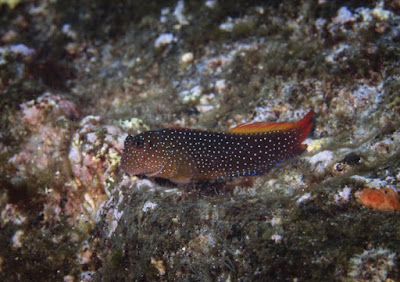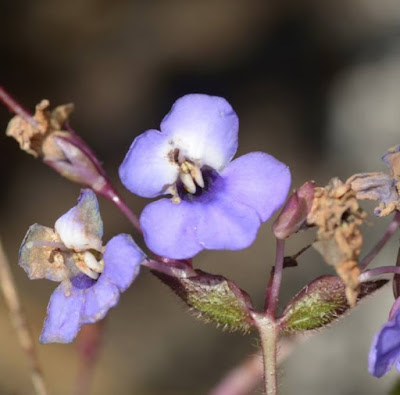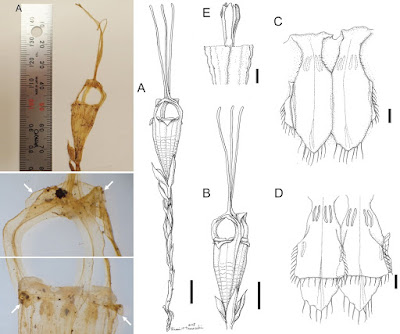[Most Recent Entries] [Calendar View]
Tuesday, December 25th, 2018
| Time | Event | ||||
| 3:05a | [Ichthyology • 2018] Evidence of Cryptic Species in the Blenniid Cirripectes alboapicalis species complex, with Zoogeographic Implications for the South Pacific
Abstract Rapa Nui, commonly known as Easter Island (Chile), is one of the most isolated tropical islands of the Pacific Ocean. The island location of Rapa Nui makes it the easternmost point of the geographic ranges for many western Pacific fish species that are restricted to the subtropical islands south of 20°S latitude. The blenniid fish species Cirripectes alboapicalis has been thought to have one of the most extensive geographic distribution ranges among these southern subtropical fish species, extending from the southern Great Barrier Reef to Rapa Nui. A phylogenetic analysis was conducted to determine the taxonomic status of the species. The results provide genetic evidence that suggests that this formerly South Pacific-wide species comprises at least three cryptic species with allopatric geographic distributions. The analyses reveal the geographic distributions of these clades and their genetic relationships with each other, and with other species within the genus Cirripectes. The processes that culminated in the current geographic distribution of this species complex and the zoogeographic implications of this finding for the South Pacific region are discussed. Keywords: Austral Islands, Blenniidae, cryptic species, cytochrome oxidase I, Easter Island, endemism, French Polynesia, Gambier Islands, Kermadec Islands, mtDNA, Phylogeny, Rangitāhua, Rapa Nui
Erwan Delrieu-Trottin, Libby Liggins, Thomas Trnski, Jeffrey T. Williams, Valentina Neglia, Cristian Rapu-Edmunds, Serge Planes and Pablo Saenz-Agudelo. 2018. Evidence of Cryptic Species in the Blenniid Cirripectes alboapicalis species complex, with Zoogeographic Implications for the South Pacific. ZooKeys. 810: 127-138. DOI: 10.3897/zookeys.810.28887 | ||||
| 6:05a | [Botany • 2018] Rachunia cymbiformis • A New Genus and Species of Gesneriaceae from Thailand
Abstract Rachunia, a new genus of Gesneriaceae from Thailand, is described with a single species, Rachunia cymbiformis. Its relationship to the rest of subtribe Didymocarpinae is investigated through a phylogenetic study based on Bayesian Inference and Parsimony analyses of nuclear ITS and plastid trnL‐trnF (intron‐spacer) sequences. Morphologically, Rachunia differs from the related genera Codonoboea in the large boat‐shaped bracts and orthocarpic vs plagiocarpic fruit; from Microchirita in the bracts, wiry vs fleshy stem, the campanulate vs tubular corolla and the clavate vs chiritoid stigma, and from Henckelia in the clavate vs chiritoid stigma, large boat‐shaped bracts in the inflorescence, free and imbricate sepals, short and campanulate corolla, clavate stigma, and relatively robust orthocarpic fruit. Keywords: phylogeny, Henckelia, Didymocarpinae
Rachunia D.J.Middleton & C.Puglisi gen. nov. Type species: Rachunia cymbiformis D.J.Middleton. Etymology: The genus is named in honour of the Thai botanist Dr Rachun Pooma of the Forest Herbarium Bangkok (BKF) to recognise his great contribution to our understanding of plant diversity in Thailand and the wider region. Rachunia cymbiformis D.J.Middleton sp. nov. Etymology: The specific epithet ‘cymbiformis’ refers to the boat-shaped bracts in the inflorescence. D. J. Middleton, G. S. Khew, M. Poopath, M. Möller and C. Puglisi. 2018. Rachunia cymbiformis, A New Genus and Species of Gesneriaceae from Thailand. Nordic Journal of Botany. 36(11); e01992. DOI: 10.1111/njb.01992 | ||||
| 7:46a | [Botany • 2018] Thismia sumatrana (Thismiaceae) • A New Species from West Sumatra, Indonesia, with Discussions on the Taxonomic Identity of Thismia clavigera
Abstract A new species of the mycoheterotrophic genus Thismia Griff. (Thismiaceae), Thismia sumatrana Suetsugu & Tsukaya, from West Sumatra, Indonesia, is described, based on a rehydrated herbarium specimen from National Museum of Nature and Science, Japan. Thismia sumatrana is closely related to T. clavigera (Becc.) F.Muell. but is distinguished by a much larger flower. Keywords: Thismia, taxonomy, new species, mycoheterotrophy, Sumatra Thismia sumatrana Suetsugu & Tsukaya, sp. nov. Diagnosis: Thismia sumatrana differs from its close relative T. clavigera, in having a much larger flower (ca. 8 cm vs. ca. 2.8 cm long). Distribution: It is known from only a single collection comprising of one flowering and one fruiting individual. Thismia sumatrana was collected from a forest floor beside a rheophytic zone along Anak Air Ganggu (Ganggu Stream), 0°33'S, 100°21'E, at Sipisang Village, Padang Pariaman, West Sumatra, Indonesia. The area was covered by mixed primary and secondary forest along a stream, where relatively natural conditions remained. For example, there were many individuals of a rare and large herbaceous plant, Amorphophallus titanum (Becc.) Becc. (Araceae). In addition, many individuals of a rheophytic plant, Furtadoa sumatrensis M.Hotta (Araceae), grew on small rocks both in the stream and on the stream bank (Mori and Okada 2001). Kenji Suetsugu, Hirokazu Tsukaya, Nurainas Nurainas and Hiroshi Okada. 2018. Thismia sumatrana (Thismiaceae), A New Species from West Sumatra, Indonesia, with Discussions on the Taxonomic Identity of Thismia clavigera. PhytoKeys. 113: 59-67. DOI: 10.3897/phytokeys.113.29103 |
| << Previous Day |
2018/12/25 [Calendar] |
Next Day >> |








